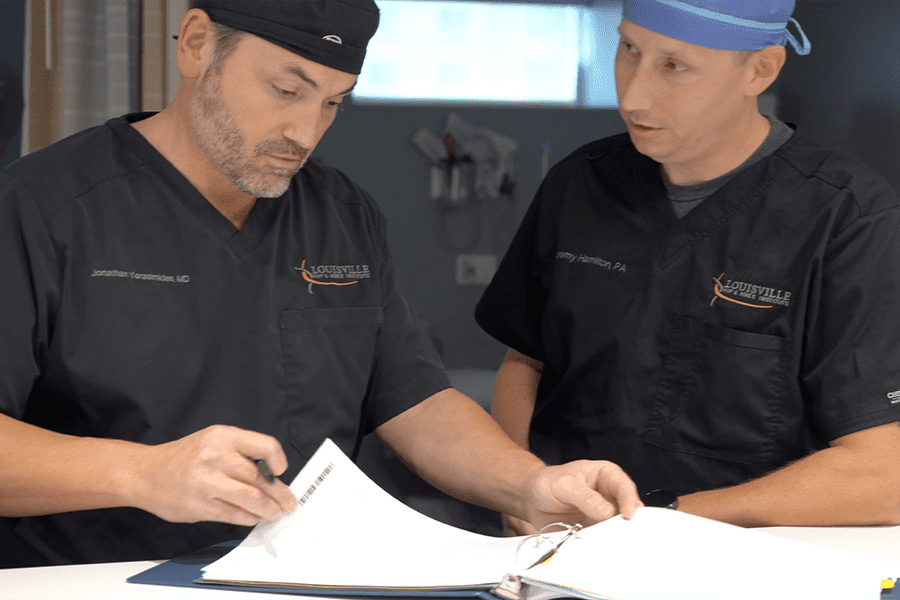- What is anterior hip replacement?
- Why is anterior hip replacement better than other types of hip surgery?
- What is recovery like with anterior hip replacement?
- When is it time to see your doctor about anterior hip replacement?
Total hip arthroplasty, also known as total hip replacement, is now one of the most common and safe orthopaedic procedures performed by surgeons every year.
Typically, 450,000 hip replacement surgeries are completed in the U.S. annually, and there are a few different approaches that surgeons use to perform them. At the Louisville Hip & Knee Institute, we have found that out of all of these approaches, anterior hip replacement surgery offers the greatest benefit to our patients.
Dr. Jonathan Yerasimides, board-certified orthopaedic surgeon who specializes in primary and revision hip replacement, recommends the anterior approach for a variety of reasons. He says, “The main benefits of anterior approach are a quicker recovery, a more stable hip, and better implant positioning.” Here are answers to common questions about anterior hip replacement.
What Is Anterior Hip Replacement?
 The hip is one of the largest joints in the body, and it plays a critical role in mobility. The joint is made up of a cup in the pelvis bone called the acetabulum and the ball formed by the upper end of the femur called the head. The bone is covered by tissue called articular cartilage that allows the ball to rotate smoothly in the socket. Thin tissue called the synovial membrane lubricates the bone and cartilage to allow your hip to function well. There are also ligaments, or thin bands of tissue connecting the ball and socket to ensure that the joint is stable during movement.
The hip is one of the largest joints in the body, and it plays a critical role in mobility. The joint is made up of a cup in the pelvis bone called the acetabulum and the ball formed by the upper end of the femur called the head. The bone is covered by tissue called articular cartilage that allows the ball to rotate smoothly in the socket. Thin tissue called the synovial membrane lubricates the bone and cartilage to allow your hip to function well. There are also ligaments, or thin bands of tissue connecting the ball and socket to ensure that the joint is stable during movement.
However, all of these moving parts are vulnerable to injury and illness. Arthritis can form just from age-related wear and tear on the joint. The cartilage that cushions the joint can simply wear away, and then the bones rub together causing pain and mobility issues.
The first hip replacement surgery was pioneered in 1891. We’ve come a long way from that inventive but risky surgery. Anterior hip replacement allows doctors to repair the damaged joint by replacing it completely with an artificial hip made of titanium, ceramic and polyethylene. The polyethylene liner is the component that wears out over time. Life expectancy of a total hip replacement today is 25-30 years.
Dr. Yerasimides says, anterior hip replacement offers a quick recovery time compared to other approaches because it “allows us to dissect in between muscle planes without releasing muscle off the bone.” This also provides a more stable hip because it doesn’t require dislocation.
The surgery takes approximately one hour to perform, and the process of anterior hip replacement looks something like this:
- After blood work and other testing confirm your health, your surgery will be scheduled.
- On the day of your surgery, you will receive general or spinal anesthesia, which will put you to sleep while the procedure is performed
- During surgery, your doctor will clean and sterilize the region around the front of the hip.
- Then, your doctor will make a cut in the front of the hip joint.
- The muscle and other tissue will be moved aside so the doctor can clearly visualize the joint.
- The doctor will cut away the upper part of the thigh bone, or the ball and socket of the hip.
- An artificial socket is inserted into your pelvis.
- An artificial ball is attached to the thigh bone with a stem inserted into the femur.
- The placement of the new joint will be reviewed to ensure everything is working properly.
- The incision is closed, and the surgery wraps up to make way for your smooth recovery.
If the anterior hip replacement occurs in an outpatient facility, you will go home the same day the surgery is performed. If you require an overnight stay, it will be performed in a hospital.
What Are the Advantages of Having Anterior Approach Hip Replacement at Louisville Hip and Knee Institute?
Just like any surgery, in inexperienced hands, there can be more complications. Louisville Hip and Knee Institute has done more anterior approach hip replacements than any practice within 300 miles of Louisville having performed over 12,000 of the procedures in the last 15 years.
Experience leads to superior results and we feel like we offer unique specialization with this procedure. There are many advantages to this approach, including:
 It can be performed in an outpatient facility
It can be performed in an outpatient facility- It allows for earlier hospital discharge
- It minimizes risks of complications
- It lessens your pain during recovery
- Implant position is more accurately controlled
- Your doctor can measure your leg length more precisely
- You can recover easier and more quickly at home
- You will find that you recover more functionality faster
- You will have fewer restrictions on post-surgery activity
- Your risk of hip dislocation post-surgery is lower
Dr. Yerasimides also points out that anterior hip replacement permits him as the surgeon to bring in an X-ray during the operation. He says this helps him “assure that the implants are exactly where they need to be and that the patient’s leg lengths are exactly correct.”
One of the goals of the practice of medicine is to improve patient experience and healthcare outcomes by improving the tools doctors use to help you get well. Anterior hip replacement is an innovative way to get patients back to health and mobility much more quickly compared to traditional surgical approaches.
While no surgery is without risk, we believe the anterior surgical approach to hip replacement is the most innovative and most patient-centered orthopaedic procedure available to our patients seeking relief from hip pain.
What Is Recovery Like With Anterior Hip Replacement?
Because the muscles around the hip joint are damaged less during anterior hip replacement, recovery is significantly less. Typically, anterior hip replacement is performed in an ambulatory surgical outpatient facility. Patients are often up and walking within two hours after surgery and can go home. Recovery includes specific exercises designed to strengthen the hip, improve range of motion.
When Is It Time To See Your Doctor About Anterior Hip Replacement?
 Pain and mobility issues caused by a worn out, arthritic hip joint can disrupt your life. It’s typical to try a variety of things to reduce pain and increase mobility.
Pain and mobility issues caused by a worn out, arthritic hip joint can disrupt your life. It’s typical to try a variety of things to reduce pain and increase mobility.
You may have tried everything from physical therapy to medications, walking with an assisted device like a cane, or even cutting back on activities you love in an effort to deal with the pain of a bad hip.
At some point, when you’re ready, it may be time to choose an orthopaedic surgeon to evaluate your options.
At Louisville Hip & Knee Institute, we are devoted to helping you regain mobility, eliminate your pain, and lead the life you deserve. Please don’t hesitate to call on us to discuss whether you are a candidate for anterior hip replacement. We can help you get your life back.

